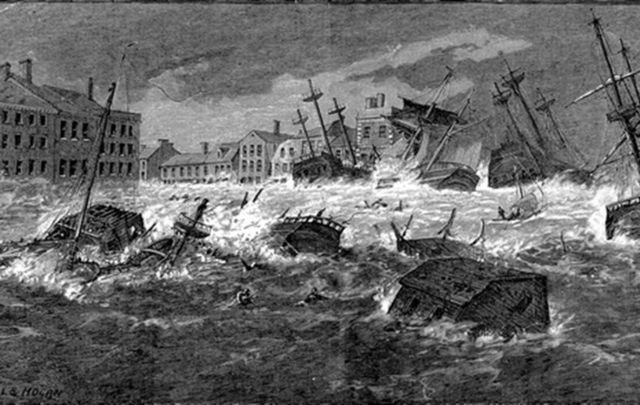January 6, 1839- The Night of the Big Wind- the worst storm in Ireland's History

Inside their cottage, Margaret Sweeney Allen was looking forward to "Nollaig na mBan" also known as "Little Christmas," the Feast of the Epiphany. In Ireland, a sweet tradition held forth that on "Little Christmas" or "Women's Christmas," the women of the family had a much anticipated day off from their household chores. For the rest of the year, a man would be ridiculed should he lift a finger to help with women's work, but on January 6th, the men of Ireland gave their wives the night off. They cared for the children and handled the household chores so the women could leave the home to gather with their female friends and family and celebrate their own "Little Christmas" without all the cooking and other chores that had been their responsibility during the preceding Christmas season. The hard working women of Ireland looked forward all year to this, their special day. Children often gave their mother's small gifts, as children do today on Mother's Day. This year Margaret had a big family to be thankful for;Mary was 13, Frank 10, John 7, Hugh 5, Patrick 4, and the baby, Peter, was only 2.
But this year the celebration was not to be. On Saturday, a heavy snow fell across the county, the first snowfall of the year. However by Sunday, the weather turned warm and eerily still. After they attended church that morning the snow was melting to slush, and as they had their Sunday dinner, a gentle rain began to fall. As it turned dark, which happened early in the winter in that northern latitude, the rain became a storm. Soon hail. sleet, and heavy rain were pounding the windows and the roof. As the children went to bed, Richard and Margaret worried at the intensity of the storm. All night it raged, wreaking havoc upon the land around them and on their own small cottage.
Reports show that many roofs gave way or were blown off by the hurricane strength winds, many precious glass windows were shattered. Chimneys were brought down and families fled their homes to avoid being crushed or killed. Some fled to neighbor's homes or nearby churches, others huddled for temporary safety in low lying areas the countryside, soaked to the skin in the freezing rain. Many fences and stone walls were also collapsed, and livestock ran in fear. Fires spread from the turf fires which were kept burning in every cottage, alighting the thatch roofs.
In nearby Dublin, the Shannon flooded. The great trees in the parks were blown down, and even stone buildings collapsed. The bell from St. Patrick's Cathedral was tossed out like a toy. As buildings fell, fires spread throughout the city. It is said that a quarter of the buildings in the city were destroyed.

The surges of the sea were so great that it was said that waves came up over the cliffs of Moher on the east coast, and on the west coast near Dublin the flooding sea enveloped the land. Ships under sail and in the harbors were wrecked, their passengers drowned.
The aftermath found many families in Meath homeless, their roofs gone, stone cottages damaged, their crops badly ruined. In the midst of winter, it was a devastating experience that would not be forgotten in the lifetimes of those who lived through it.
(You may want to read- "The Big Wind- a novel of Ireland" by Beatrice Coogan)
No comments:
Post a Comment